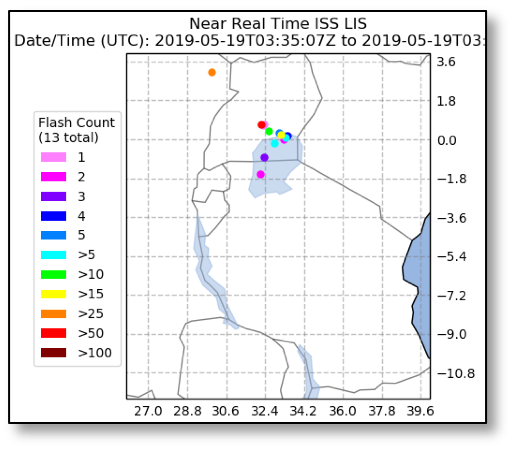
The Earth Networks Global Lightning Network (ENGLN) is a ground-based lightning detection network that detects total (in-cloud (IC) and cloud-to-ground (CG)) lightning using the time-of-arrival of radio signals at multiple receiving stations within the frequency spectrum between 1 Hz and 12 MHz (Thompson et al., 2014; Rudlosky, 2015; Nag et al., 2015). The peak current, time, and location of a stroke are determined from the time and signal amplitude data. Multiple strokes within 10 km and 700 ms are termed a flash. Flashes with one or more return strokes are classified as a CG flash. Flashes without a return stroke are classified as an IC flash. Beginning in 2014, Earth Networks (EN) established a network of lightning sensors around Lake Victoria, providing the first opportunity to examine continuous observations of total lightning in this region. A recent climatology of lightning in the Lake Victoria Basin examines the occurrence and intensity of lightning (Virts et al., 2020).

- A. Nag, M. J. Murphy, W. Schulz, and K. L. Cummins, Lightning Locating Systems: Insights on characteristics and validation techniques, Earth and Space Science, doi: 10.1002/2014EA000051, 2015.
- Rudlosky, S. D., “Evaluating ENTLN Performance Relative to TRMM/LIS,” Journal of Operational Meteorology, Vol. 3 Issue 2, p11- 20. 10p, 2015.
- Thompson, Kelsey B., Bateman, Monte G., Carey, Lawrence D., “A Comparison of Two Ground-Based Lightning Detection Networks against the Satellite-Based Lightning Imaging Sensor (LIS),” Journal of Atmospheric and Oceanic Technology, vol. 31, issue 10, pp. 2191-2205, 2014.
- Virts, K. S., and S. J. Goodman, 2020: Prolific Lightning and Thunderstorm Initiation over the Lake Victoria Basin in East Africa, Mon. Wea. Rev, in review.






